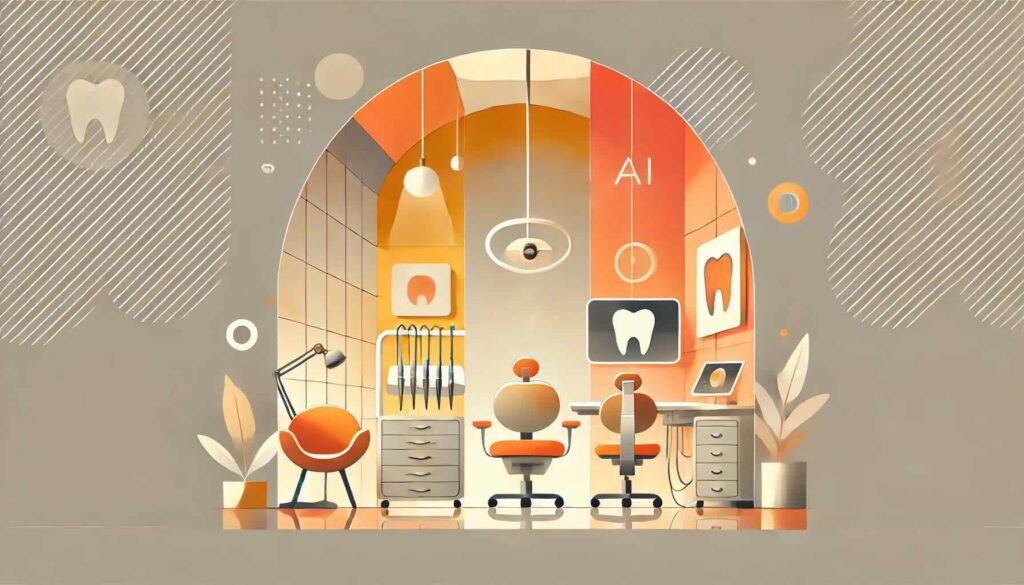Artificial intelligence (AI) is no longer just a buzzword; it’s a transformative force that’s reshaping industries across the board, including dentistry. For many, the term “AI” might still conjure images of futuristic robots or complex algorithms far removed from the practical realities of a dental practice. However, understanding the fundamentals of AI is becoming increasingly important for dentists who want to stay ahead of the curve and leverage this technology to enhance both clinical and operational aspects of their work.
In this blog post, we’ll break down the essential concepts of AI in a way that’s relevant to dental professionals. We’ll explore what AI is, how it works, and the specific ways it can be applied in dentistry to improve patient care, streamline operations, and ultimately, elevate your practice.
What Is AI, and Why Should Dentists Care?
At its core, artificial intelligence refers to the simulation of human intelligence by machines, particularly computer systems. These systems are designed to perform tasks that typically require human intelligence, such as learning, reasoning, problem-solving, and decision-making. AI can process vast amounts of data quickly and accurately, identifying patterns and insights that might be difficult or impossible for humans to detect on their own.
For dentists, this means that AI has the potential to revolutionize many aspects of your practice. Whether it’s enhancing diagnostic accuracy, automating routine administrative tasks, or providing personalized treatment recommendations, AI offers tools that can improve efficiency, reduce errors, and deliver better outcomes for patients.
Key Components of AI: Machine Learning, Deep Learning, and Natural Language Processing
To understand how AI works, it’s important to familiarize yourself with some of the key components that power this technology:
- Machine Learning (ML):
- Machine learning is a subset of AI that focuses on the development of algorithms that allow computers to learn from and make decisions based on data. In the context of dentistry, ML can be used to analyze patient records, recognize patterns in diagnostic images, and predict outcomes for treatment plans.
- Deep Learning:
- Deep learning is a more advanced form of machine learning that involves neural networks with many layers. These networks are capable of processing complex data inputs, such as medical images, and are particularly useful in fields like radiology and pathology, where they can assist in detecting anomalies and diagnosing conditions with high accuracy.
- Natural Language Processing (NLP):
- Natural language processing is another branch of AI that enables machines to understand, interpret, and respond to human language. For dentists, NLP can be used to automate the transcription of patient notes, improve communication with patients through chatbots, and streamline the documentation process.
AI in Clinical Dentistry: Enhancing Diagnostics and Treatment Planning
One of the most exciting applications of AI in dentistry is its ability to enhance diagnostics and treatment planning. Traditionally, diagnosing dental conditions and planning treatments have relied heavily on the expertise and experience of the dentist. While this human element will always be crucial, AI can provide valuable support by analyzing data with a level of speed and precision that’s unmatched by human capabilities.
- Radiographic Analysis: AI-powered tools can analyze dental X-rays and CT scans with incredible accuracy, identifying issues such as cavities, periodontal disease, and even early signs of oral cancer. These tools can highlight areas of concern that might be missed in a manual review, ensuring that nothing slips through the cracks.
- Predictive Analytics: By analyzing historical patient data, AI can help dentists predict the likelihood of future issues, such as the progression of tooth decay or the development of gum disease. This allows for more proactive treatment plans, potentially saving patients from more invasive procedures down the line.
- Predictive Analytics: By analyzing historical patient data, AI can help dentists predict the likelihood of future issues, such as the progression of tooth decay or the development of gum disease. This allows for more proactive treatment plans, potentially saving patients from more invasive procedures down the line.
- Personalized Treatment Recommendations: Every patient is unique, and AI can help tailor treatment plans to the individual needs of each patient. By considering a wide range of factors—such as medical history, lifestyle, and genetic predispositions—AI can suggest the most effective treatment options, improving outcomes and patient satisfaction.
AI in Operational Dentistry: Streamlining Office Management
Beyond the clinical applications, AI also holds tremendous potential for streamlining the operational aspects of running a dental practice. Administrative tasks can be time-consuming and prone to error, but AI-driven tools can automate many of these processes, freeing up your team to focus on patient care.
Appointment Scheduling:
AI-powered scheduling systems can optimize appointment bookings, reducing gaps in the schedule and minimizing patient wait times. These systems can also send automated reminders to patients, reducing no-shows and ensuring that your practice runs smoothly.
Billing and Insurance Claims:
Processing insurance claims and handling billing can be a headache for many dental offices. AI can automate much of this process, ensuring that claims are submitted accurately and promptly. This not only reduces the administrative burden on your staff but also improves cash flow by minimizing delays in payment.
Patient Communication:
AI chatbots can handle routine inquiries from patients, such as appointment confirmations, directions to the office, and basic post-procedure care instructions. This ensures that patients receive timely responses, even outside of regular office hours, improving their overall experience with your practice.
Overcoming the Challenges of AI Adoption in Dentistry
While the benefits of AI in dentistry are clear, it’s also important to acknowledge the challenges that come with adopting this technology. Dentists may face concerns about the cost of AI tools, the learning curve associated with new systems, and the potential impact on the patient-dentist relationship.
Cost:
Investing in AI technology can be expensive, especially for smaller practices. However, it’s important to view this investment in the context of long-term savings and improved efficiency. Many AI tools can pay for themselves over time by reducing the need for manual labor, decreasing errors, and improving patient retention.
Learning Curve:
Implementing AI in your practice will require some time and effort to learn how to use these new tools effectively. It’s essential to provide training for your staff and to choose AI solutions that are user-friendly and well-supported by the vendor.
Patient Trust:
Some patients may be wary of AI, fearing that it could replace the personal touch they value in their interactions with their dentist. It’s crucial to communicate that AI is a tool that enhances—not replaces—the care provided by the dentist. Emphasize that AI allows you to spend more time focusing on patient care, rather than administrative tasks.
The Future of AI in Dentistry: What’s Next?
As AI continues to evolve, its role in dentistry will only grow. We can expect to see even more advanced diagnostic tools, greater integration of AI into patient management systems, and the development of AI-powered devices that assist with procedures in real-time.
AI-Assisted Procedures:
Imagine a future where AI-guided robotics assist in dental surgeries, providing real-time feedback and precision that enhances the dentist’s skills. While this may sound like science fiction, research and development in this area are already underway, and we may see these innovations in dental offices sooner than we think.
Advanced Patient Monitoring:
AI could also play a role in ongoing patient monitoring, using wearable devices to track oral health metrics and alert both the patient and dentist to potential issues before they become serious problems.
Integration with Other Technologies:
The integration of AI with other emerging technologies, such as 3D printing and telemedicine, will further expand its capabilities. This could lead to more personalized and accessible care, with AI helping to design custom dental appliances and even enabling remote consultations.
Conclusion: Embracing AI to Elevate Your Practice
Artificial intelligence is not just a futuristic concept; it’s a present-day reality that’s transforming the way dentists work. By understanding the fundamentals of AI and exploring its applications in both clinical and operational contexts, you can unlock new opportunities to enhance patient care, improve efficiency, and stay ahead in an increasingly competitive field.
As AI technology continues to advance, now is the time for dentists to embrace these tools and integrate them into their practices. By doing so, you’ll not only provide better care for your patients but also position your practice for success in the years to come.
If you’re interested in learning more about how AI can benefit your dental practice, join us at our upcoming event, where we’ll dive deeper into the fundamentals of AI and explore its specific applications in dentistry. This is your chance to stay ahead of the curve and discover how AI can elevate your practice to new heights.
Sign up for the event here.

